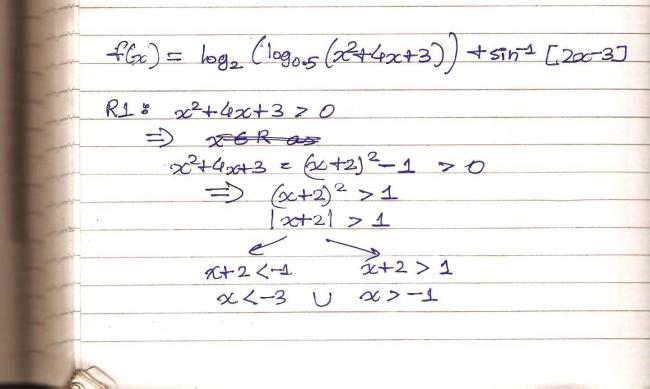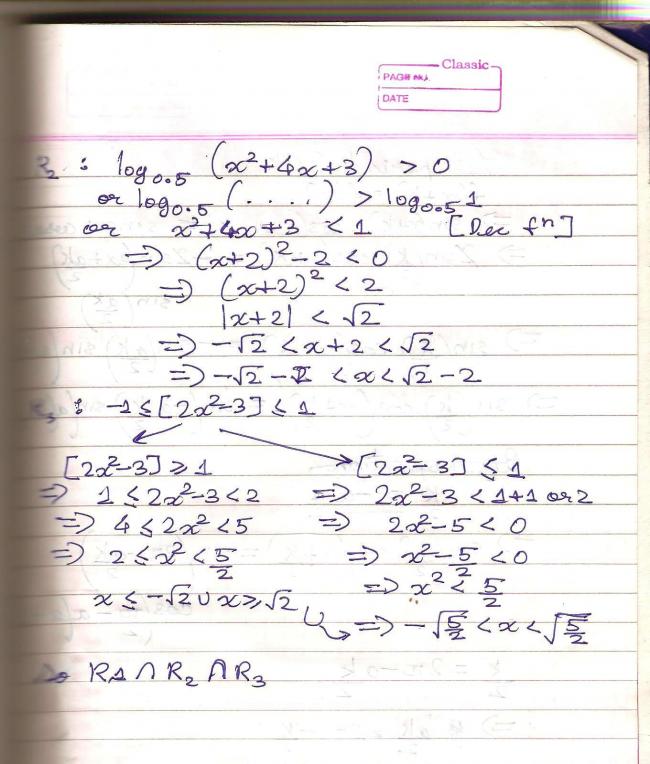ans for the fifth one is a b and c ... sinx>0 is the only condition ..
Q1. Let the function f(x) = x2+x+sinx-cosx+log(1+|x|) be defined on the interval [0,1]. The function g(x) on [-1,1] satisfying g(-x) = -f(x) is
ans given: -x2+x+sinx-cosx+log(1+|x|) (wrong naa?)
Q2. If f:R-->R is defined by f(x) = x2+1, teh value of f-1(17) and f-1(3) are respectively
ans given: {-4,4}, φ (how can inverse even be defined????)
Q3. Domain of f(x) = log2(log0.5(x2+4x+3)) + sin-1[2x2-3] is [.] is GIF
Q4. Consider the following sets
R = \begin{Bmatrix} (x,y) |x,y\epsilon R,\; x^2+y^2\leq 25 \end{Bmatrix}
R' = \begin{Bmatrix} (x,y) |x,y\epsilon R,\; y\geq 4x^2/9 \end{Bmatrix}
Is R ∩ R' a function? If so, find its domain and range
-
UP 0 DOWN 0 0 11

11 Answers
adding more questions...
MULTI ANSWERS (ALL)
Q5. Let f(x) = \frac{\sqrt{sinx}}{1+\sqrt[3]{sinx}}. If D is the domain of f, then D contains
(a) (0,pi) (b) (-2pi,-pi) (c) (2pi,3pi) (d) (4pi, 6pi)
ans given: ac
Q6. Let f(x) = sin(\frac{\pi}{x}) and D+ = {x|f(x) > 0}. Then D+ contains
(a) (1/3, 1/2) (b) (1/5, 1/4) (c) (-1, -1/2) (d) (-pi -1/2)
ans given: abc
Q7. Let f(x) = x2, g(x) = √x, tehn
(a) gof(-2) = 2
(b) gof(4) = 4
(c) gof(3) = 6
(d) gof(2) = 4
ans given: b
Q8. SOLVED (VERIFIED BY WOLFRAM ANS: 1/3)
\lim_{x\rightarrow 0}\frac{tanx-x}{x^2tanx}
ans shud be 1/3 naa?
ans for the 8th question must be 1/3 .. and in the sevenh question g(x) is not mentioned if we take the second function as g(x) then ul get gof=x so answer is a and b .. since f(x) is an even function f(2)=f(-2)=4 ...
Q5. R1 => sinx ≥ 0
This implies x → [0, pi]
R2 => 1 + 3√sinx ≠0
This implies sinx ≠3√-1
Assuming real domain, sinx ≠-1
So x ≠(2n + 1)pi/2, n = 1,2,3..
So [0, pi] and [2pi, 3pi] possible.
for the sixth question also the answer is a b and c same concept as the 5th question
7.gof=√(x2)=|x|
from the given options,a and b are thus correct.
dont know why only b has been given.
for q 2,the function
i)is not onto as it takes values in [1,∞)
ii)is not one one as any value a and -a have the same y(a2+1)
the function clearly is not invertible.

